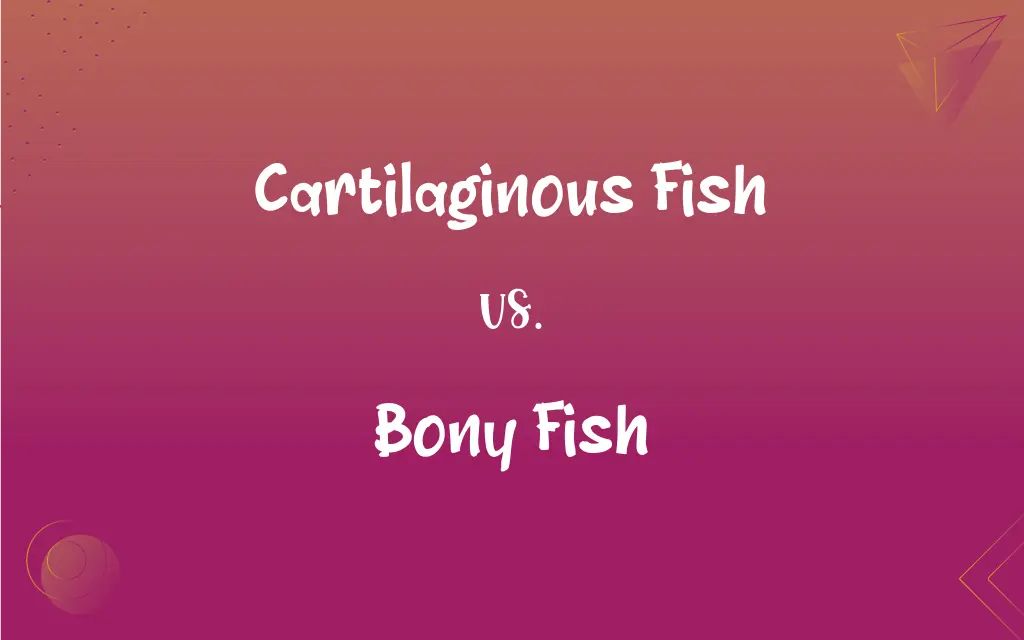Cartilaginous Fish vs. Bony Fish: What's the Difference?
Edited by Aimie Carlson || By Harlon Moss || Updated on October 16, 2023
Cartilaginous fish have skeletons made of cartilage, e.g., sharks. Bony fish have skeletons made of bone, e.g., salmon.

Key Differences
Cartilaginous fish are marine species characterized by having skeletons made entirely out of cartilage. In contrast, bony fish, which can be found both in freshwater and marine environments, possess a skeleton primarily composed of bone.
In the world of fish, cartilaginous fish are unique for their flexible skeletal system, allowing for a wide range of movement. On the other hand, bony fish, with their stiffer skeletal structure, often exhibit different swimming patterns and behaviors due to the rigidity provided by their bones.
The group of cartilaginous fish includes species like sharks, rays, and skates. These creatures often have rough skin covered with dermal denticles, giving them a sandpaper-like texture. Bony fish, such as trout, bass, and tuna, typically have scales covering their bodies and exhibit a variety of vibrant colors and patterns.
Respiration in cartilaginous fish is often facilitated by multiple gill slits, whereas bony fish typically breathe through a single pair of gills protected by a gill cover. Additionally, while bony fish have a swim bladder that helps in buoyancy, most cartilaginous fish do not.
Comparison Chart
Skeleton
Made of cartilage
Made of bone
ADVERTISEMENT
Skin Texture
Rough with dermal denticles
Smooth with scales
Respiration
Multiple gill slits
Single pair of gills with gill cover
Buoyancy Mechanism
Largely liver oil; no swim bladder
Possesses a swim bladder
Habitat
Mostly marine
Freshwater and marine
Cartilaginous Fish and Bony Fish Definitions
Cartilaginous Fish
Cartilaginous fish are aquatic animals with skeletons made solely of cartilage.
Sharks are a well-known type of cartilaginous fish.
ADVERTISEMENT
Bony Fish
Bony fish typically have scales covering their body, offering protection and sometimes vibrant colors.
The shimmering scales on a trout reveal its identity as a bony fish.
Cartilaginous Fish
These fish belong to the class Chondrichthyes and include sharks, rays, and skates.
Stingrays, gliding gracefully in the ocean, are cartilaginous fish.
Bony Fish
Belonging to the class Osteichthyes, these fish are the most diverse and numerous of all fish groups.
With thousands of species, the bony fish category includes creatures like goldfish.
Cartilaginous Fish
Cartilaginous fish generally have multiple gill slits for respiration.
The multiple gill openings you see on a shark identify it as a cartilaginous fish.
Bony Fish
Unlike cartilaginous fish, bony fish possess a swim bladder that helps in maintaining buoyancy.
The ability of a bony fish, like the betta, to float effortlessly is due to its swim bladder.
Cartilaginous Fish
These fish usually lack a swim bladder, relying on liver oil for buoyancy.
The cartilaginous fish, unlike bony fish, do not use a swim bladder for floating.
Bony Fish
Bony fish are aquatic vertebrates with skeletons primarily made of bone.
Salmon, popular in many dishes, is a type of bony fish.
Cartilaginous Fish
Cartilaginous fish have a unique skin texture covered in tiny tooth-like structures called dermal denticles.
The rough skin of the shark is because it's a cartilaginous fish with dermal denticles.
Bony Fish
Bony fish breathe through a single pair of gills usually protected by a bony cover or operculum.
The single gill cover on the side of a perch is characteristic of bony fish.
FAQs
What characterizes bony fish?
Bony fish are aquatic vertebrates with skeletons primarily made of bone and include species like salmon, tuna, and trout.
Are sharks considered bony fish?
No, sharks are cartilaginous fish with skeletons made of cartilage.
Do cartilaginous fish have scales?
No, instead of scales, cartilaginous fish have rough skin covered with dermal denticles.
What helps bony fish maintain buoyancy in water?
Bony fish possess a swim bladder that aids in buoyancy.
Can cartilaginous fish feel pain?
While their nervous system differs from ours, it's believed that cartilaginous fish can experience pain.
What are cartilaginous fish?
Cartilaginous fish are aquatic animals with skeletons made of cartilage, including sharks, rays, and skates.
Are cartilaginous fish found in freshwater?
While primarily marine, some cartilaginous fish species, like certain stingrays, can be found in freshwater.
How do bony fish reproduce?
Most bony fish reproduce by laying eggs, though some species give birth to live young.
Do bony fish have multiple gill slits?
No, bony fish typically have a single pair of gills protected by a bony cover.
Which has more species, cartilaginous or bony fish?
Bony fish, with over 30,000 species, far outnumber the cartilaginous fish.
Do cartilaginous fish have a swim bladder?
Most cartilaginous fish lack a swim bladder and rely on liver oil for buoyancy.
How do bony fish protect themselves?
Many bony fish have scales, spines, and sometimes even toxins to deter predators.
How do bony fish differ in body structure?
Bony fish often have more rigid skeletal structures due to their bone composition.
How do cartilaginous fish reproduce?
Cartilaginous fish exhibit various reproductive strategies, including oviparity, viviparity, and ovoviviparity.
Which is older evolutionarily, cartilaginous or bony fish?
Cartilaginous fish evolved before bony fish in Earth's history.
Do bony fish have teeth?
Yes, many bony fish species possess teeth, but their size and shape can vary greatly.
Why are bony fish more colorful than cartilaginous fish?
Bony fish often possess vibrant colors for reasons like camouflage, communication, and mate attraction.
What's the importance of cartilage in cartilaginous fish?
Cartilage provides flexibility, allowing cartilaginous fish to move and bend efficiently.
Are there endangered cartilaginous fish species?
Yes, many species of sharks and rays are currently at risk due to overfishing and habitat loss.
What's the primary habitat for bony fish?
Bony fish are found in both freshwater and marine habitats.
About Author
Written by
Harlon MossHarlon is a seasoned quality moderator and accomplished content writer for Difference Wiki. An alumnus of the prestigious University of California, he earned his degree in Computer Science. Leveraging his academic background, Harlon brings a meticulous and informed perspective to his work, ensuring content accuracy and excellence.
Edited by
Aimie CarlsonAimie Carlson, holding a master's degree in English literature, is a fervent English language enthusiast. She lends her writing talents to Difference Wiki, a prominent website that specializes in comparisons, offering readers insightful analyses that both captivate and inform.































































